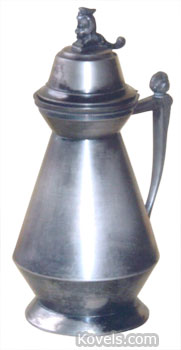Q: My mother-in-law gave me this item and I have no idea was it is. It appears to be a pitcher of some sort. It’s 8 inches tall. I can’t read all of the mark, but it says “….Hall Miller Co., …reble plate, Patented Oct. 24, 1865.” Can you tell me what it was used for and who made it?
A: You have a syrup jug or molasses pitcher made by Simpson, Hall, Miller & Co. of Wallingford, Connecticut. The company was founded by Samuel Simpson in 1866 and became part of International Silver Co. in 1898. The words you can’t read are “treble plate,” which means that there are three layers of silver plate on the base metal. The 1865 patent was granted to John A. Parise and C.W. MacCord of New York City for the design of a “molasses-pitcher” that prevented drips from running down the outside. Liquid in their pitcher poured from a spout inside a funnel-shaped mouth. Drips were caught in the mouth, an “overflow receiver,” and ran back into the pitcher through an opening in the neck.




Thank you so much for the information. Now I wonder if it has any value other than just decor.